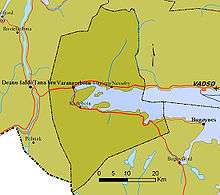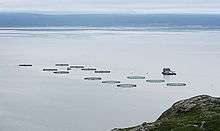Nesseby
| Nesseby kommune Unjárgga gielda | |||
|---|---|---|---|
| Municipality | |||
|
Abelsborg in Nesseby municipality | |||
| |||
 Nesseby within Finnmark | |||
| Coordinates: 70°10′24″N 28°33′13″E / 70.17333°N 28.55361°ECoordinates: 70°10′24″N 28°33′13″E / 70.17333°N 28.55361°E | |||
| Country | Norway | ||
| County | Finnmark | ||
| District | Øst-Finnmark | ||
| Administrative centre | Varangerbotn | ||
| Government | |||
| • Mayor (2011) | Knut Inge Store (Ap) | ||
| Area | |||
| • Total | 1,436.37 km2 (554.59 sq mi) | ||
| • Land | 1,366.89 km2 (527.76 sq mi) | ||
| • Water | 69.48 km2 (26.83 sq mi) | ||
| Area rank | 57 in Norway | ||
| Population (2014) | |||
| • Total |
919 ( | ||
| • Rank | 410 in Norway | ||
| • Density | 0.64/km2 (1.7/sq mi) | ||
| • Change (10 years) | -0.9 % | ||
| Demonym(s) | Nessebyværing[1] | ||
| Time zone | CET (UTC+1) | ||
| • Summer (DST) | CEST (UTC+2) | ||
| ISO 3166 code | NO-2027 | ||
| Official language form | Bokmål and Sami | ||
| Website |
www | ||
|
| |||
Unjárga (Northern Sami) or Nesseby (Norwegian) (also Uuniemi in Kven/Finnish) is a municipality in Finnmark county, Norway. The administrative centre of the municipality is the village of Varangerbotn. Other villages in Nesseby include Gandvik, Karlebotn, Nesseby, and Nyelv. The European route E06 and European route E75 highways intersect at Varangerbotn in Nesseby.
General information

The municipality of Nesseby was originally established in 1839 when the western part of the Vadsø landdistrikt was separated to form Nesseby. Initially, there were 598 residents. This was short-lived, however, since the two were merged back together in 1858. On 1 January 1864, the municipality of Nesseby was again created from the western district of Vadsø landdistrikt. The initial population (this time) was 886. The western part of Nesseby (population: 450) was separated on 1 January 1903 to form the new municipality of Polmak.[2]
Name
The official name of the municipality was Nesseby before 1989 when it was changed to Unjárga-Nesseby.[3] It was the second municipality in Norway to get a Sami name. In 2005, the name was again changed, such that either Unjárga or Nesseby can be used.[4]
The municipality (originally the parish) is named after the old Nesseby farm, since Nesseby Church was built there (in 1858). The first element is nes which means "headland" and the last element is by which means "town".[5]
The meaning of the first element (u-) in the Sami name is unknown and the last element is njárga which means "headland".[5]
Coat-of-arms
The coat-of-arms is from modern times. They were granted on 27 June 1986. The arms show a cloudberry plant (Rubus chamaemorus), since these plants are commonly found in the municipality and the region. The berries were historically exported to other parts of Norway by the barrel.[6][7]
Churches
The Church of Norway has one parish (sokn) within the municipality of Nesseby. It is part of the Indre Finnmark deanery in the Diocese of Nord-Hålogaland.
| Parish (sokn) | Church name | Location | Year built |
|---|---|---|---|
| Nesseby | Nesseby Church | Nesseby | 1858 |
History


Wild reindeer used to cross the isthmus in prehistoric times until the year 1900, causing extensive human activity throughout the millennia. Therefore, the area is full of archeological finds from different periods.
Sami culture
Most inhabitants are of Sami origin, and today Sami is being taught as the first language in schools. The municipality has its own Sami costume.
The Norwegian Sami Parliament's department of culture and environment is located in Unjárga-Nesseby. The Várjjat Sámi Museum is located in the municipality. The museum is about the sea-sami culture. Unjárga-Nesseby is also the birthplace of Isak Saba the first Sami to be elected into the Norwegian Parliament.
The popular teen-age pop-band The Blacksheeps come from Nesseby.
Government
All municipalities in Norway, including Nesseby, are responsible for primary education (through 10th grade), outpatient health services, senior citizen services, unemployment and other social services, zoning, economic development, and municipal roads. The municipality is governed by a municipal council of elected representatives, which in turn elect a mayor.
Municipal council
The municipal council (Kommunestyre) of Nesseby is made up of 15 representatives that are elected to every four years. Currently, the party breakdown is as follows:[8]
| Party Name | Name in Norwegian | Number of representatives | |
|---|---|---|---|
| Labour Party | Arbeiderpartiet | 7 | |
| Socialist Left Party | Sosialistisk Venstreparti | 2 | |
| Local Lists | Lokale lister | 6 | |
| Total number of members: | 15 | ||
Geography
The municipality is situated on the isthmus between the Varangerfjord and the Tana River at the entrance to the Varanger Peninsula. All the people live in small settlements along the fjord. Varangerhalvøya National Park is partially located in the park. The river Jakobselva partially forms the municipal border between Nesseby and Vadsø to the northeast.
Birdlife
The municipality of Unjárga-Nesseby is known for its interesting birding localities and is mentioned in several birding guide books. Other than the Varangerford, the main habitat is tundra with areas of bog and marsh. One species that can usually be seen on small ponds during the summer months is the red-necked phalarope.
Climate
| Climate data for Varangerbotn | |||||||||||||
|---|---|---|---|---|---|---|---|---|---|---|---|---|---|
| Month | Jan | Feb | Mar | Apr | May | Jun | Jul | Aug | Sep | Oct | Nov | Dec | Year |
| Daily mean °C (°F) | −11.9 (10.6) |
−11.0 (12.2) |
−7.4 (18.7) |
−2.3 (27.9) |
3.1 (37.6) |
8.6 (47.5) |
12.2 (54) |
10.5 (50.9) |
6.1 (43) |
0.3 (32.5) |
−5.7 (21.7) |
−9.9 (14.2) |
−0.6 (30.9) |
| Average precipitation mm (inches) | 27 (1.06) |
22 (0.87) |
21 (0.83) |
21 (0.83) |
24 (0.94) |
37 (1.46) |
55 (2.17) |
53 (2.09) |
44 (1.73) |
41 (1.61) |
34 (1.34) |
31 (1.22) |
410 (16.14) |
| Source: Norwegian Meteorological Institute[9] | |||||||||||||
References
- ↑ "Navn på steder og personer: Innbyggjarnamn" (in Norwegian). Språkrådet. Retrieved 2015-12-01.
- ↑ Jukvam, Dag (1999). "Historisk oversikt over endringer i kommune- og fylkesinndelingen" (PDF) (in Norwegian). Statistisk sentralbyrå.
- ↑ "Ot.prp. nr. 111 (2001-2002)" (in Norwegian). Regjeringen.no.
- ↑ "Endring av skrivemåten for tospråklige kommuner. Endring av skrivemåten for tospråklige kommunenavn, Unjárga-Nesseby" (in Norwegian).
- 1 2 Rygh, Oluf (1924). Norske gaardnavne: Finmarkens amt (in Norwegian) (18 ed.). Kristiania, Norge: W. C. Fabritius & sønners bogtrikkeri. p. 246.
- ↑ Norske Kommunevåpen (1990). "Nye kommunevåbener i Norden". Retrieved 2008-12-11.
- ↑ "Kommunevåpen". Flags of the World. 28 June 2002. Retrieved 2008-12-11. External link in
|publisher=(help) - ↑ "Table: 04813: Members of the local councils, by party/electoral list at the Municipal Council election (M)" (in Norwegian). Statistics Norway. 2015.
- ↑ "eKlima Web Portal". Norwegian Meteorological Institute.
External links
| Wikimedia Commons has media related to Nesseby. |
- http://www.nesseby.kommune.no/ Official homepage (Norwegian)
- http://www.varjjat.org/ Várjjat Sámi Museum (Sami)
- http://www.isaksaba.no/ Isak Saba center (Sami)


